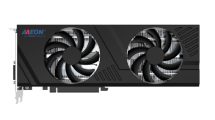The fact that the MorePowerTool from Hellm and the Red BIOS Rebellion Team (R.B.R.T.) in the background for RDNA3 will no longer exist in the usual form has already been reported by some media, but somewhat unreflected and unfortunately with insufficient source information. It is important for us to note that the R.B.R.T is not a group of “several programmers” or “forum users”, but specialists who have come together in their spare time and have set themselves a common goal: namely to give end users exactly that functionality for their Radeon cards that AMD denies them for many reasons. This extends to the Wattman, which, besides various bugs, does not even begin to offer what makes the Radeon cards more efficient or faster from the customer’s point of view. Mostly even both.
Hellm has not only given it a functional GUI, but has put a lot of heart and soul into implementing features that have made it easier to work with AMD’s Radeon cards. The whole team collected, verified and tested information, Hellm finalized the whole thing as usable software and we here at igor’sLAB hosted the software, collected feedback and even took action against fakes and fake download sites not only once. This first of all as a correction, because it was unfortunately wrongly spread. We all know that the RDNA cards in particular often enough first mature at the customer and in the meantime even a very large community has formed, which with a lot of its own time and patience ultimately brings the products to where you would like to see them.
Hellm recently commented on the problem in a third-party forum, and the discussion is currently in full swing in our forum as well. However, in order to read all of this in its proper context, I ask that you please go to the forum page linked below. There you can also find the details about how AMD is now not only slowing down the end customer, but also their own board partners (AIB) to a certain extent. Obviously, one has “learned” a lot from NVIDIA and even overtook Team Green including its “Green Light Program” (GLP) on the right.
Read more here: Forum discussion (multilingual)
Specialists such as gupsterg (along with his friends), various industry sources, and also Veii have ultimately had to conclude that penetrating the current security mechanisms is very difficult and, above all, could also result in certain consequences for which the team is no longer willing or able to take responsibility. In the end, this is no longer just about copyright infringement, but about breaking a security structure that would, in the worst case, also make the affected hardware very vulnerable to access by third parties or malware. In the end, everything is always possible somehow, but that would have to happen at a price that no one wants to pay anymore.
Yes, everything is double and triple secured. You would also have to change the firmware and adapt drivers, which is not really possible. Not even under Linux, where just AMD’s next target group is rudely disappointed. However, this does not mean that there will be no more software from the team at all. Other ways will be sought (and found) to give the cards a bit more usability where AMD offers shortcomings in its own software. Here, of course, I ask for a little more time on behalf of everyone.
What drives AMD and how far do they still go?
First of all, however, it is important to note that every manufacturer is free to do whatever they want with their products and the associated ecosystem, and what they think is right. From this point of view, we also have no right to criticize the manufacturer for anything. It is what it is, and AMD will certainly have seen good reasons to change and seal off the entire system. However, as a responsible customer, as well as at NVIDIA, you should be allowed to formulate your own thoughts from an end user’s point of view.
AMD has not only copied a lot from NVIDIA, but has also put a lot of effort into it. Malicious tongues could now remark that this energy would have been better spent on the efficiency and performance of the hardware and software, and they might even be right to a certain extent. Besides the loss of image due to the lack of overclocking features, there won’t be any dominance in the various bests anytime soon. This is no longer intelligent marketing, but ends in a kind of self-mutilation by depriving oneself of showcase features (HWBOT, 3DMark, etc.). Even though overclockers and also the undervolters certainly don’t make up the majority of customers – they are immensely important multipliers and they are also very clearly noticed. This branch, on which one has been sitting very comfortably up to now, has just been sawed off with relish.
If you have read my articles about RDNA3 carefully, then you also know that AMD has started to calculate the power consumption of the entire board instead of a TGP for the GPU and the memory and to use these values, analog to NVIDIA, for the limitation. However, NVIDIA has (unfortunately) been overtaken here as well. While the GeForce cards still rely on shunts (voltage drop) and a suitable monitoring chip, AMD does it via the so-called Inductor DCR and a lot of mathematical fiddling in the firmware to extrapolate the value reasonably accurately. This “internal” monitoring of all relevant voltage transformers instead of external current feeds is consistent in that it excludes any “shunt mods” from the outset. This system can also be attacked, but it would require much more effort if the TBP were to be broken open. It is possible, but hardly anyone will do it, since, for example, the coils would have to be modified.
If AMD had succeeded with RDNA3, which they had announced as late as November 2022, the anger and disappointment would certainly be less. Those who are in front also have to pedal less. It’s just downright depressing when a GeForce RTX 4090 with an optimized VF curve and significantly less than 300 watts of power consumption can still draw huge circles around a Radeon RX 7900 XTX in games, which has to use its power budget ad nauseam so that it doesn’t look too embarrassing.
If you end up offering only the second-fastest product, you’re known to sell it primarily on price, divergent features (optimizability), or the hearts of brand-savvy users (community). If only the price remains at the end, the whole thing is kind of a shame.




































147 Antworten
Kommentar
Lade neue Kommentare
Veteran
Urgestein
Neuling
Urgestein
1
Urgestein
Urgestein
Urgestein
Urgestein
Moderator
Mitglied
Veteran
Urgestein
Urgestein
Urgestein
Urgestein
Mitglied
Urgestein
1
Alle Kommentare lesen unter igor´sLAB Community →